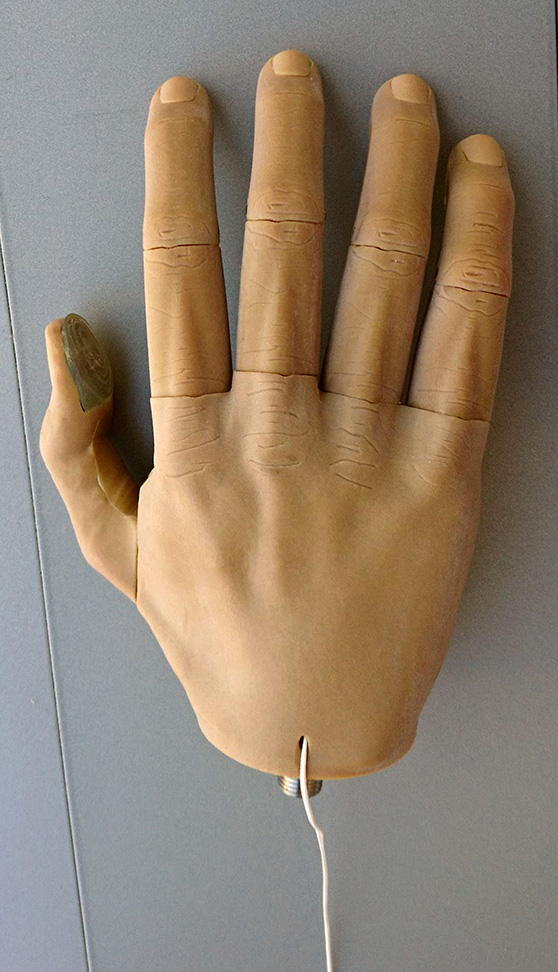Need & Significance
Body
This study is complete and is no longer recruiting subjects.
Losing an arm has profound economic, social, and psychological effects. People with an arm amputation need an artificial arm (prosthesis) that can effectively replace lost function, enabling them to live independently, work, and participate in society.
Assuming the same incidence of major limb amputation as in the United States (0.014%) on a world-wide scale, at least a million people live with arm amputations, most of them in low-income countries. Whereas approximately 80% of patients with an arm amputation in the United States use a prosthesis, prosthetic usage is far lower in many low-income countries, reflecting the both the high cost of even simple prostheses relative to income levels and a lack of access to clinicians and other resources. For many people in high-income countries too, access to prosthetic care is limited by cost.
Current Options
Body
Prosthetic Sockets
A prosthesis is attached to the user through a socket that fits snugly over the residual limb and must be comfortable, easy to clean, and durable. In the United States, sockets are custom made in a multi-step process using a cast of the residual limb. The process requires multiple clinic visits, a highly trained prosthetist, and specialized equipment—resources that are typically not available in low-income countries.
Arm Prostheses
Powered arm prostheses are expensive and not strong enough to use in jobs such as farming, making them unsuitable for many people in low-income countries.
Body-powered prostheses are controlled by movements of the user’s body, typically the shoulder, transmitted to the prosthesis through a pulley/Bowden cable system. This type of prosthesis is commonly used in low-income countries and often preferred in the US, as they are strong, simple to use, relatively inexpensive to buy and repair, and the user gets some sensory feedback from the prosthesis through the cables.
Most body-powered prosthesis users in the United States chose to use a prehensor (hook) instead of a hand, because available body-powered hands only provide one grasp, are heavy, inefficient (largely because thick gloves are needed to make the hands look natural), and are hard to use. Although hooks may work better than hands, many individuals would prefer a hand, and hooks are not culturally acceptable in some countries.
Our Low-Cost Arm System
Body

Through generous funding from the Bohnen Family Foundation, we have developed the following components of a low-cost prosthetic arm system:
—A simple, rapid, and inexpensive method for making sockets that does not require clinical training, specialized equipment or electricity, and can be completed in one visit, in less than 90 minutes.
—A very low-cost, strong body-powered hand that provides up to three functional grasps, and looks very natural.
Our development process for the hand and socket relied on 3D printed plastics; however, these plastics are not strong enough to withstand daily use in a prosthesis. Our final designs will be manufactured using injection-molded plastics, which are very strong, can be made in a wide variety of colors, and can be made very inexpensively in large quantities.
With RERC funding, we will:
—Optimize the design through user testing and feedback
—Send our arm system to collaborators in Central and South America and India to obtain their feedback
—Work with industrial partners to optimize the cosmetic appearance of the system and to select a strong plastic with multiple color options for the final design.
—Create injection molds to manufacture each part of the design
—Perform a clinical trial in the United States to evaluate the final design (and obtain feedback from users in India and Central/South America)
—Create videos and written training materials, so that individuals with minimal training can fit prostheses
We expect that our arm system will provide access to functional, affordable prosthetic devices for individuals in low-income countries and provide a valuable prosthetic option for low-income or uninsured individuals in the United States.
Lead Personnel
Body
Laura Miller, CP, PhD (Principal Investigator)
Jim Lipsey, MS, PE
Frank Ursetta, MS
Kristi Turner, MHS, OTR/L
Ann Barlow, PhD
Mentioned Profile

Laura Miller, CP, PhD
Team Scientist II/Prosthetist Associate ProfessorPublications & Presentations
Body
Patent
Kuiken T, Ursetta F, inventors; Rehabilitation Institute Of Chicago D/b/a Shirley Ryan Abilitylab, assignee. Injection molded prosthetic limb system and related methods. United States patent application US 15/729,063. 2018 Apr 12.
Paper
Miller LA, Pickerill T, Kuiken TA. A novel, low-cost transradial socket fabrication method using mass-producible components and expanding rigid foam. Prosthetics and Orthotics International. 2020 Aug 25:0309364620950850.
Body
The contents of this webpage were developed under grants from the National Institute on Disability, Independent Living, and Rehabilitation Research (NIDILRR grant numbers 90RE5014 (2013-2018) and 90REGE0003 (2018-2023). NIDILRR is a Center within the Administration for Community Living (ACL), Department of Health and Human Services (HHS). The contents of this webpage do not necessarily represent the policy of NIDILRR, ACL, or HHS, and you should not assume endorsement by the Federal Government.
